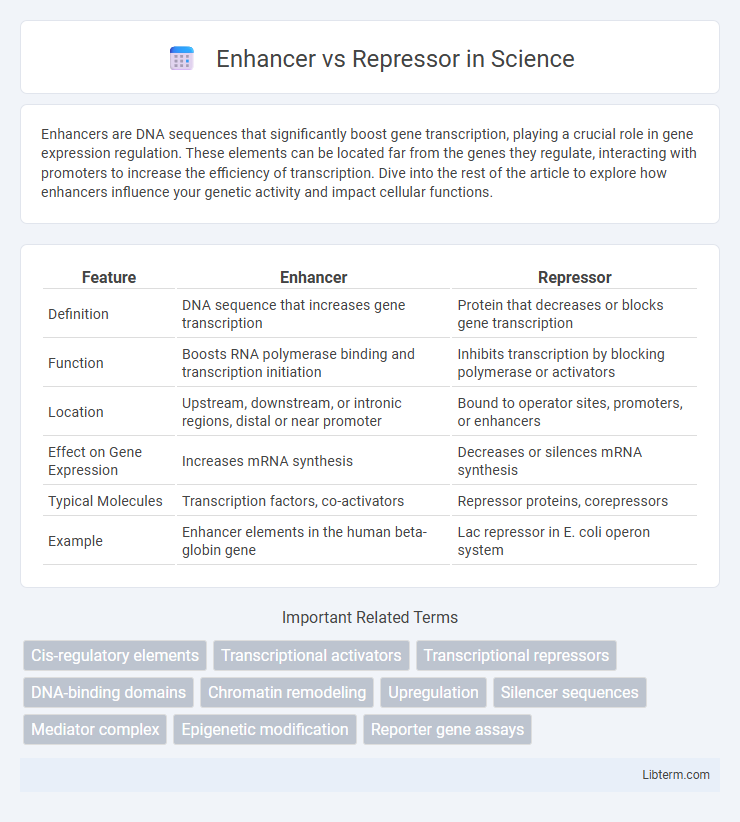Enhancers are DNA sequences that significantly boost gene transcription, playing a crucial role in gene expression regulation. These elements can be located far from the genes they regulate, interacting with promoters to increase the efficiency of transcription. Dive into the rest of the article to explore how enhancers influence your genetic activity and impact cellular functions.
Table of Comparison
| Feature | Enhancer | Repressor |
|---|---|---|
| Definition | DNA sequence that increases gene transcription | Protein that decreases or blocks gene transcription |
| Function | Boosts RNA polymerase binding and transcription initiation | Inhibits transcription by blocking polymerase or activators |
| Location | Upstream, downstream, or intronic regions, distal or near promoter | Bound to operator sites, promoters, or enhancers |
| Effect on Gene Expression | Increases mRNA synthesis | Decreases or silences mRNA synthesis |
| Typical Molecules | Transcription factors, co-activators | Repressor proteins, corepressors |
| Example | Enhancer elements in the human beta-globin gene | Lac repressor in E. coli operon system |
Introduction to Gene Regulation
Enhancers are DNA sequences that increase the transcription levels of associated genes by facilitating the binding of transcription factors and RNA polymerase, thus promoting gene expression. Repressors are regulatory proteins that bind to specific DNA regions or silencers to inhibit transcription and reduce gene expression. The dynamic interplay between enhancers and repressors is fundamental to precise gene regulation, enabling cells to respond to developmental cues and environmental signals.
What Are Enhancers?
Enhancers are regulatory DNA sequences that increase the transcription of specific genes by binding transcription factors and facilitating the assembly of the transcriptional machinery. These elements can function over long distances from the target gene, often looping through chromatin to interact with promoters. Enhancers play a crucial role in controlling gene expression patterns during development and cellular differentiation.
What Are Repressors?
Repressors are proteins that bind to specific DNA sequences called operators to inhibit gene transcription, effectively preventing the expression of certain genes. These regulatory proteins play a crucial role in gene expression control by blocking RNA polymerase from initiating transcription or by recruiting other proteins that modify chromatin to a repressive state. Repressors are essential for cellular function and adaptation, enabling organisms to turn off genes in response to environmental signals or developmental cues.
Mechanisms of Enhancer Function
Enhancers function by facilitating the assembly of the transcriptional machinery at gene promoters through DNA looping, enabling transcription factors and coactivators to interact effectively with RNA polymerase II. They recruit mediator complexes and chromatin remodelers that alter nucleosome positioning, increasing accessibility of the promoter region to the transcriptional apparatus. These mechanisms enable enhancers to increase transcription rates independent of their position or orientation relative to the target gene.
Mechanisms of Repressor Function
Repressors inhibit gene expression by binding to specific DNA sequences called operators or silencers, blocking the recruitment or activity of RNA polymerase. They can interfere with transcription initiation by hindering enhancer-promoter interactions or by recruiting co-repressors that modify chromatin structure to a closed, inactive state. Some repressors also stabilize nucleosomes or promote histone deacetylation, further compacting chromatin and preventing transcription factor binding.
Enhancers vs Repressors: Key Differences
Enhancers and repressors are regulatory DNA sequences that modulate gene expression by influencing transcription factor binding. Enhancers increase the transcriptional activity of specific genes by facilitating the assembly of the transcriptional machinery, often through interaction with activator proteins. Repressors, in contrast, inhibit gene expression by blocking transcription factor binding or recruiting co-repressor complexes that condense chromatin, reducing accessibility to the transcriptional machinery.
Biological Examples of Enhancers
Enhancers are DNA sequences that increase the transcription of specific genes by binding transcription factors, as seen in the enhancer region of the beta-globin gene cluster in humans, which regulates hemoglobin production during development. The SV40 virus enhancer is a widely studied example, enhancing expression of viral genes and host cellular genes by recruiting activator proteins. Enhancer elements in the MyoD gene play a critical role in muscle differentiation by facilitating the binding of transcription factors like MyoD and MEF2.
Biological Examples of Repressors
Repressors are proteins that bind to specific DNA sequences, such as operators, to inhibit gene transcription by blocking RNA polymerase activity. In bacteria, the lac repressor binds to the lac operator, preventing the transcription of lactose-metabolizing genes in the absence of lactose. In eukaryotes, the NRSF/REST repressor silences neuronal gene expression in non-neuronal tissues by recruiting chromatin remodeling complexes.
Clinical Relevance: Enhancers and Repressors in Disease
Enhancers and repressors critically regulate gene expression, with mutations or dysregulation often linked to various diseases including cancer, autoimmune disorders, and neurodevelopmental conditions. Altered enhancer activity can lead to overexpression of oncogenes, while dysfunctional repressors may fail to suppress harmful gene expression, contributing to tumor progression and inflammatory diseases. Understanding the clinical relevance of these regulatory elements enables targeted therapies such as CRISPR-based gene editing and epigenetic drugs aimed at restoring balanced gene expression.
Future Perspectives in Gene Regulatory Research
Emerging technologies like CRISPR-based epigenome editing are transforming the ability to precisely modulate enhancers and repressors, enabling targeted control of gene expression with unprecedented accuracy. Single-cell multi-omics and advanced computational modeling are providing deeper insights into the dynamic interplay between these regulatory elements, uncovering context-dependent mechanisms that drive cell differentiation and disease progression. Future research aims to harness enhancer and repressor functions for personalized gene therapies, synthetic biology applications, and innovative treatments for complex genetic disorders.
Enhancer Infographic

 libterm.com
libterm.com